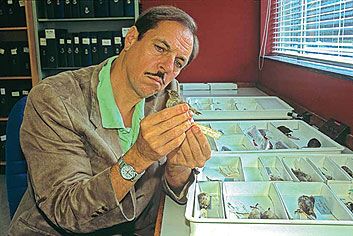Natural Selection
In Darwin’s Galápagos Islands, evolution is on display
/https://tf-cmsv2-smithsonianmag-media.s3.amazonaws.com/filer/ed_bird.jpg)
Wild animals' usual wariness of human beings is not always evident in the Galápagos Islands, owing to the remarkable naiveté of the creatures there. Frank Sulloway stood only about two feet away from the hawk below when he photographed it. "The bird was completely relaxed in my presence, looking at me inquisitively with one eye and then with the other in order to obtain binocular perspective," Sulloway says. "After I snapped this picture, the hawk spotted a large grasshopper a few yards behind me and alighted. As it flew by me, its right wing brushed against my face."
Sulloway, a historian of science and a visiting professor at the University of California at Berkeley, has been fascinated by the Galápagos and its most famous visitor, Charles Darwin, since he was a Harvard undergraduate in the mid-1960s. Sulloway first visited the islands in 1968, when he retraced Darwin's voyage on the HMS Beagle for a documentary film. He has been back eight times.
In "The Evolution of Charles Darwin" (p. 58), Sulloway casts a fresh eye on the great scientist's work there—and on how Darwin almost missed the revolutionary insight with which he will be forever linked.
In 1970, during his second Galápagos trip, Sulloway came across another hawk, one that was trying to capture a marine iguana almost as large as the bird itself. For more than three hours, Sulloway watched the pair battle: "The hawk had the marine iguana by the neck with its sharp talons," Sulloway recalls. "Every few minutes the iguana would attempt to escape by suddenly moving its wiry and muscular body in every direction. Eventually, by this strategy, the iguana succeeded in getting loose. It ran to a shallow cove nearby and submerged itself. The hawk followed and patiently waited at the water's edge. Minutes went by. Eventually the iguana reappeared on the opposite side of the cove, about ten yards from the hawk. That move unfortunately sealed its fate, as the hawk pounced once again, this time with fatal result. I remember thinking that this is natural selection in action, here before my eyes, and in Darwin’s islands!"
A reminder: January 5 marks the deadline for our third annual photo contest. For categories, rules and on-line submission instructions, please go to http://photocontest.smithsonianmag.com/.

/https://tf-cmsv2-smithsonianmag-media.s3.amazonaws.com/accounts/headshot/carey-winfrey-240.jpg)
/https://tf-cmsv2-smithsonianmag-media.s3.amazonaws.com/accounts/headshot/carey-winfrey-240.jpg)